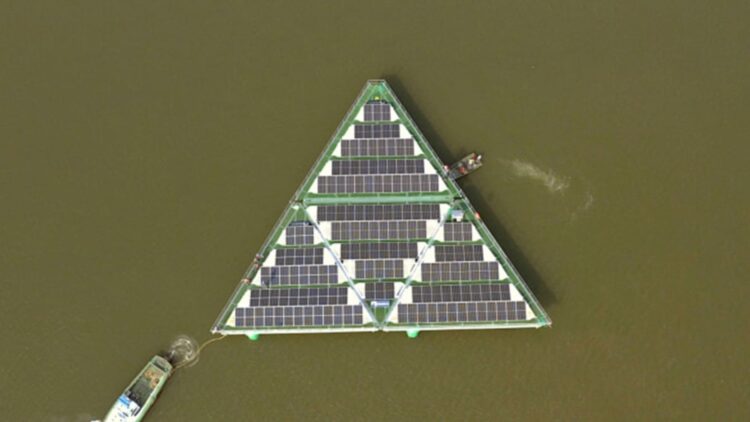With its first inland floating solar installation being revealed in April 2021, Europe’s SolarDuck tests triangular photovoltaics yet again. In April 2021, the Dutch renewable-energy innovator’s solar installation on the Waal River near IJzendoorn was shown and it comprised of four rigid triangular platforms to host solar panels that were more than three meters above the waterline. Hydrogen generation is ensured by a 10 kW electrolyzer that produces 65 kW of power.
Looking into the design of the Waal River pilot project
While SolarDuck’s North Sea pilot project has 0,5 MWp of capacity, SolarDuck’s Waal River pilot project is the one to focus on. Utilizing offshore and maritime expertise, SolarDuck was able to create a floating solar structure. Every triangular platform can be measured at 16 m × 16 m × 16 m, fabricated using offshore-grade aluminium for lightness and integrity.
With platforms being mounted atop floating pillars, the panels get elevated more or less three meters out of the water to mitigate wave impact and keep vital electrical components dry. All units tend to be connected in a flexible way so that the maritime heritage is leveraged to ensure a floating structure is created that is somewhat of resilient against the currents and conditions at sea. The floating structure must be able to tolerate hurricane-force winds.
Shifting the focus to on-site hydrogen integration
In totality, the Waal River Pilot system delivers a combined solar capacity of more or less 65 kW and draws power solely through conventional PV modules. These PV modules were sourced from Astronergy. The system ultimately gets linked to a 10 kW electrolyzer that encourages on-site hydrogen production and expands on SolarDuck’s vision to integrate floating PV with green hydrogen systems. While on-site, hydrogen integration is ensured, SolarDuck sees this Waal pilot project as a step towards near-shore solar farms.
All triangular platforms are engineered so as to be tesselated into configurations that form hexagonal clusters that can deliver 10 MWp and beyond. The company, however, is not stopping there. SolarDuck wishes to deploy larger pilots in perhaps more trying environmental conditions, including the 0,5 MWp North Sea project in collaboration with RWE, and a 5 MW floating array integrated with offshore wind installations being scheduled.
Ensuring deployment and operational success
Construction happened more than seven months ago at Damen Shipyards, where the four platforms were towed using a 50 km high-speed route through the Waal to their installation sites. A real-world test of structural robustness was ensured, and all the platforms performed well. The pilot project is set to cost more or less €1 million along with the €350,000 funded by the Province of Gelderland. SolarDuck has thus partnered with local industrial players such as Engie Solutions, DSM Advanced Solar, Chint Solar, Damen Shipyards Group, and Dekker Group to ensure the project becomes fruitful.
The project also gained Approval in Principle (AIP) from Bureau Veritas, signifying the very first certification for floating offshore solar technology and validating the design under offshore renewable standards.
America, too, is seeing what happens when 10,000 rooftops vanish under solar coastlines.
SolarDuck’s pilot project ensures a successful pathway to renewable energy
With SolarDuck’s floating solar pilot on the Waal River, a merger of solar energy technologies and inland waterways is clear. Thanks to the project’s triangular platform design, hydrogen integration is possible in a practical and innovative way. Due to successful demonstrations under real-world conditions, a certificate was gained from Bureau Veritas, paving the pathway to scalable and sustainable solutions whilst utilizing the offshore floating solar pilot. SolarDuck is setting its focus on larger deployments and is looking to reimagine the pathway towards renewable energy. With India testing a new source too, we could soon be saying goodbye to photovoltaics since the future is floatovoltaics.


